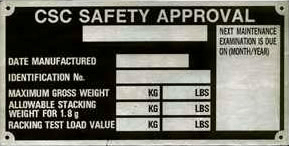ISO freight containers offer versatile solutions for storage and transportation, making the shipping process smooth and efficient. Here, you’ll get a breakdown of ISO shipping container sizes and types, helping you choose the suitable containers for your shipment needs.
What is an ISO container?
An ISO container is an intermodal container designed for efficient delivery across various transportation modes, including trucks, rail, and ships. These containers adhere to the specifications set by the International Organization for Standardization (ISO).
Mostly, people use ISO shipping containers to deliver heavy loads and palletized products. Due to the exposure to elements during shipping, particularly when transported by trucks or cargo ships, they are built with durability to withstand harsh weather and extreme conditions.
Container safety certificate (CSC)
ISO containers come with a container safety certificate issued by the manufacturer, which must be renewed every 30 months by a certified inspector. Alternatively, it is possible to use an approved continuous examination program (ACEP) instead of this procedure.

Types and sizes of ISO shipping containers
Standard ISO shipping containers typically measure 20 or 40 feet in length and 8 feet in width. The height can vary between standard height (8 feet 6 inches) and high cube (9 feet 6 inches).
The most common ISO freight container types are 20ft, 40ft, and 40ft high cubes. These containers are ideal for shipping dry cargo, such as machinery, grains, paper, and electronics.
Want to learn more about ISO dry containers? Continue reading for detailed information about the container measurements of 20 and 40ft.
20ft ISO container measurements
This ISO container size is popular due to its convenient smaller dimensions. It is easy to load and unload from vessels and can be handled at ports without advanced lifting equipment. Additionally, it is ideal for intermodal transportation.
Here are the dimensions of a 20ft ISO container:
Internal length: 19.4 feet (5.9m)
Internal width: 7.8 feet (2.35m)
Internal height: 7.9 feet (2.39m)
Payload capacity: Roughly 52,000 lbs (24,000kg)
Cubic capacity: 1,172 cubic feet (33CBM)
40ft ISO container dimensions
The 40ft ISO standard container is another popular choice for shipping dry goods, offering double the length of its 20ft counterpart. It typically costs only about 20-30% more than the 20ft container but provides double the space!
Here are the dimensions of a 40ft ISO shipping container:
Internal length: 39 feet 5.5 inches (12.03m)
Internal width: 7 feet 8 inches (2.35m)
Internal height: 7 feet 9 inches (2.39m)
Payload capacity: 58,920 lbs (26,760 kg)
Cubic capacity: 2,389 cubic feet(67.7CBM)
40ft HC ISO container sizes
The 40ft high cube is similar to the standard 40ft dry container but with added height, making it suitable for shipping taller or out-of-gauge cargo. It also allows you to fit more goods into the cargo space.
Check out the dimensions of a 40ft HC ISO shipping container here:
Internal length: 39.5 feet (12m)
Internal width: 7.8 feet (2.8m)
Internal height: 8.10 feet (2.7m)
Payload capacity: 63,052 lbs (28,600 kg)
Cubic capacity: 2,694.5 cubic feet (76.3CBM)
Special purpose container
Besides the standard ISO container, there are specialized-use shipping containers designed to meet specific requirements.
This category includes refrigerated containers, flat rack containers, tank containers, etc. These containers can transport temperature-sensitive items, liquids, gases, or oversized/irregularly shaped cargo.
Common modifications include:
- Adjusting the height and width of the container.
- Installing technological equipment.
- Varying door positions.
- Adding extra doors.
- Removing the container roof.
In the following section, we’ll explore the dimensions and uses of these special ISO containers in more detail.
Flat racks and platforms are ISO shipping containers designed for shipping heavy machinery. They lack side walls but may have end bulkheads and are often collapsible.
Open-top containers resemble a box and can be loaded from the top or end. They are perfect for heavy, tall, or hard-to-load goods like coal or grain.
Insulated or thermal containers are advantageous for chilled, frozen, or temperature-sensitive cargo. They have insulated walls to maintain internal temperatures but do not have refrigeration units.
ISO reefer or refrigerated containers come equipped with built-in refrigeration units. These temperature-controlled containers are essential for perishables and other goods that need a consistent environment to maintain quality.
ISO tank containers have the standard dimensions as other ISO freight containers but feature cylindrical tanks mounted within a rectangular steel frame. These specialized containers are perfect for transporting liquids or bulk materials.
For detailed information on the size and capacity of these special-purpose containers, check out our articles below.
ISO coding, identifying, and marking
ISO 6346, also known as the BIC code, is an international standard that specifies the identification system for shipping containers.
Maintained by the International Container Bureau (BIC), this standard includes essential details such as the serial number, owner, country code, category identifier, type, and size of any shipping container.

Where category identifiers include:
J: detachable shipping container-related equipment
R: refrigerated containers
U: freight containers
Z: trailers and chassis
ISO container size and type codes
| ISO Type Group | ISO Size Type | ||
|---|---|---|---|
| Code | Description | Code | Description |
| 20GP | General Purpose Cont. | 20G0 | General Purpose Cont. |
| 20GP | General Purpose Cont. | ||
| 20HR | Insulated Cont. | 20H0 | Insulated Cont. |
| 20GP | General Purpose Cont. | 20G0 | General Purpose Cont. |
| 20PF | Flat (Fixed Ends) | 20P1 | Flat (Fixed Ends) |
| 20TD | Tank Cont. | 20T3 | Tank Cont. |
| 20T4 | Tank Cont. | ||
| 20T5 | Tank Cont. | ||
| 20T6 | Tank Cont. | ||
| 20TG | Tank Cont. | 20T7 | Tank Cont. |
| 20TN | Tank Cont. | 20T0 | Tank Cont. |
| 20T1 | Tank Container | ||
| 20T2 | Tank Container | ||
| 22GP | General Purpose Cont. | 22G0 | General Purpose Cont. |
| 22G1 | General Purpose Cont. | ||
| 42GP | General Purpose Cont. | 42G0 | General Purpose Cont. |
| 42G1 | General Purpose Cont. | ||
| 42RC | Reefer Cont. (No Door) | 42R9 | Reefer Cont. (No Door) |
| 42RS | Reefer Cont. (Diesel Gen.) | 42R3 | Reefer Cont. (Diesel Gen.) |
| 42RT | Reefer Cont. | 42R1 | Reefer Cont. |
| 45GP | High Cube Cont. | 45G0 | High Cube Cont. |
| 45G1 | High Cube Cont. | ||
| 45PC | Flat(Collapsible) | 45P3 | Flat(Collapsible) |
| 45P8 | Flat(Collapsible) | ||
| 45RC | Reefer Cont. (No Door) | 45R9 | Reefer Cont. (No Door) |
| 45RT | Reefer High Cube Cont. | 45R1 | Reefer High Cube Cont. |
For a more comprehensive list of BIC codes, click here to check.
Conclusion
If you’re a shipper, we understand the challenge of finding the right standard ISO container for your shipments. At Airsupply, we have the perfect solution for you.
With our extensive network of over 1,500 global shipping lines, you can book standard and special containers of all types.
In addition, we can swiftly adapt our customized options to offer you the most competitive prices and the fastest delivery times possible by keeping abreast of the latest market trends and container supply and demand dynamics.
FAQs about ISO freight container
Which ISO standards are vital for shipping containers?
Important ISO standards for shipping containers include ISO 668 (regarding Classification, Dimensions, and Ratings), ISO 1496 (focused on Specification and Testing), ISO 6346 (related to Coding, Identification, and Marking), ISO 1161 (regarding Corner Fittings), and ISO 3874 (covering Handling and Securing).
Who oversees the global regulation of shipping containers?
The oversight of shipping container regulation globally involves several entities, with the International Maritime Organization (IMO) and the Bureau of International Containers (BIC) playing crucial roles in establishing and advocating for international standards.




